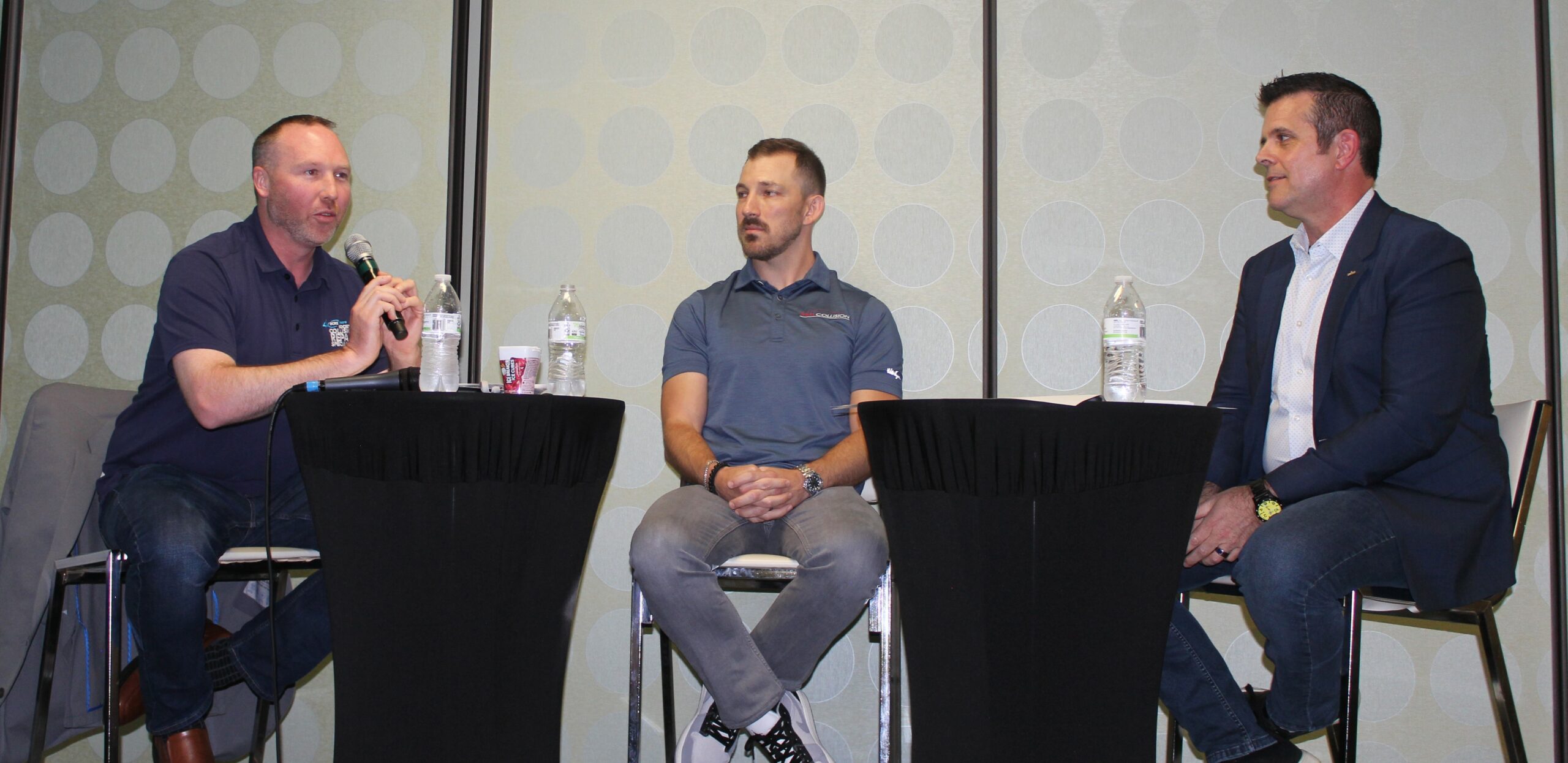
Shop owners share how to rethink traditional employee roles and business structure
By onBusiness Practices
Three collision repair shop owners recently shared how they’ve implemented employee role segmentation and its positive impacts on workforce skills development, productivity, repair quality, and overall operations efficiency.
The panel discussion was held May 17 at the Southeast Collision Conference in Greensboro, North Carolina. The panelists were Kris Burton, Rosslyn Auto Body owner/operator in Alexandria, Virginia; Michael Bradshaw, vice president of K&M Collision in Hickory, North Carolina, and Barry Dorn, vice president of Dorn’s Body & Paint in Mechanicsville, Virginia.
“Role segmentation is the strategic division of tasks within any organization in the specialized roles, and this ensures that individuals can focus on specific tasks and functions,” Bradshaw said.
He added that segmentation optimizes resource use by each individual and the company as a whole as well as reduces errors. Bradshaw attributed the decrease in errors he’s seen at his shop to his employees focusing on the same tasks repetitively, improving along the way.
The panel compared the business operation to that of the aerospace industry with quality control processes, OEM repair procedures, cross-functional teams, and individuals with certain expertise handling the corresponding repair processes from engineers to technicians. Both industries are also built on constantly learning, honing skills, and enriching expertise, according to the panel.
“There’s a lot of things that we have to do that we keep consistently seeing is very similar to what they have to do,” Dorn said. “When it comes down to the procedures, you can’t ignore that.”
He added that’s especially important not only for the safe repairs but also when it comes to liability, which would be on the repair shop, not the insurance carrier.
“Things are only going to become more complex so the further we put off specialization and segmentation within the industry, the further behind the eight ball we’re going to be,” Bradshaw said. “Our technicians train a lot. I sometimes feel like we’re paying them to train more than we are to work on cars.
“We understand that’s part of the deal; that it’s an investment that we have to make to ensure the technicians are going to be skilled and equipped to repair the vehicles properly.”
Segmentation and specialization lead to a better ability to make safe repairs every time and contribute to a continuous improvement culture, Bradshaw said.
“We encourage our technicians to contribute ideas to improve our processes,” Bradshaw said. “We literally will tear something up because somebody has a better idea and we will go through pain for 30 or 45 or 60 days because we know it’s eventually going to be better. That’s something that you really have to keep an open mind to, to innovate… and grow your team. You’ve got to be comfortable with change because there’s going to be a lot of it if you want to go through this process.”
Dorn noted that changes won’t happen overnight, and might not be successful at first. In fact, it didn’t work out the first time for Dorn’s. He said their process was too flawed, too many things were tried at once, and they didn’t have buy-in support from their team.
Bradshaw gave an overview of the role titles and tasks of the employees at K&M:
In Bradshaw’s shop:
-
- Customer Service Representative (CSR) — handles customers only and is the customers’ advocate
- Blueprinter — lives on the shop floor, writing every repair plan at the vehicles from a computer cart
- Structural technician
- Disassembly technician
- Reassembly technician
- Mechanical technician
- Glass technician
- Structural prepper
- Painter
- Parts team — the manager focuses solely on inventory management while another receives parts, mirror-matches them, and checks for damage
Bradshaw asked the audience, “The person that you want dealing with the customer, is that the same personality trait that you want back there studying the vehicle and ensuring that you’re getting a complete and thorough estimate? Aren’t those kind of two different personality types? …How much time is that estimator dedicating to researching that repair and ensuring he’s writing an accurate repair plan if he’s juggling all this other stuff?
He and Burton noted as well that the efficiency and productivity of blueprinters are improved by equipping their carts with dual or ultra-wide monitors so they can pull up parts diagrams, procedures, and the estimating system at the same time.
At Dorn’s, the blueprinter writes the repair plan and the repair planner sells that plan to the third-party payer or the customer, he said.
“We segregate our blueprint team from the carrier so blueprint only deals with the technician and the car,” Dorn said.
Burton’s shop recently began changing up operations. He said one of the challenges they’ve faced is some technicians don’t like change and don’t see that they need to make some changes.
“After 30 to 60 days, we’re processing vehicles quicker, the quality is up, and overall it’s been good for everybody,” Burton said.
Dorn added, “If you’ve been in this game a long time, you have some level of Stockholm syndrome and that’s what you’ve got to try to get out because that’s the Achilles heel to getting you where you need to be.
“When you’re segmenting, you may have this person that does X, and this person has a strength at doing X, but keep in mind they don’t want to be there forever. They want to move around, especially the [younger] generation that we’re working with now. They don’t want to stay in one role for an extended amount of time.”
It’s important to have a career path for technicians and to grow your own people, Dorn added. His shop doesn’t hire from within the collision repair industry; they want to train their employees from the beginning.
The panel agreed that implementing these role and operations changes won’t necessarily cost more because the goal is to look for opportunities to improve efficiency with what and who shops already have. They’ve been working on honing their processes over the last five to 10 years.
Images
Featured stock image credit: Hispanolistic/iStock
(From left) Kris Burton, Rosslyn Auto Body owner/operator in Alexandria, Virginia; Michael Bradshaw, vice president of K&M Collision in Hickory, North Carolina, and Barry Dorn, vice president of Dorn’s Body & Paint in Mechanicsville, Virginia participating in a panel discussion on May 17, 2024 at the Southeast Collision Conference in Greensboro, North Carolina. (Lurah Lowery/Repairer Driven News)

